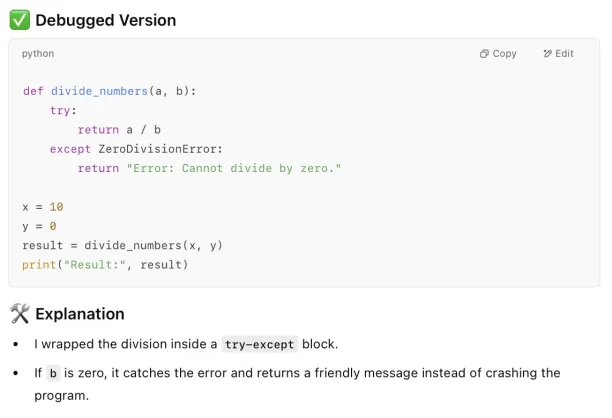Over the last two decades, we’ve helped companies deploy advanced analytics, mainly for automation. The solutions then prevailing were robust in some contexts, but they were not able to respond to change.
Since it is a GenAI tool, ChatGPT is flexible and can serve as an enterprise employee copilot. However, its applications are limited by factors including hallucinations.
In 50 ChatGPT Use Cases with Real-Life Examples, you can find more information about customer service, HR, and coding applications.
Industry-Specific Use Cases for ChatGPT Automation
1- Content automation
ChatGPT can automate content creation by using its natural language generation (NLG) capabilities to generate human-like text. With its large dataset and advanced neural network architecture, ChatGPT can learn patterns in human language and develop coherent and contextually appropriate responses to various prompts.
To use ChatGPT automation for content creation, a business or individual can provide prompts or topics to the model, and the model can generate content based on that input. For example, a company could give a list of keywords or phrases related to their product or service. ChatGPT automations could generate a series of blog post titles and outlines based on those inputs.
ChatGPT can streamline content creation by generating marketing copy, blog posts, and social media captions.
For example, a marketing team can use ChatGPT to create multiple ad copy variations, optimizing them for A/B testing.
2- Personalized Marketing
ChatGPT automations can analyze customer data to create personalized marketing messages, enhancing engagement and conversion rates. It can automatically segment audiences and adjust the tone and content based on individual preferences and behavior.
In retail and e-commerce, ChatGPT can analyze user data, such as purchase history or browsing behavior, to provide tailored product recommendations.
For instance, customers who frequently shop for fitness equipment might receive personalized suggestions for yoga mats or dumbbells. Similarly, in education, it can recommend relevant courses, books, or study materials based on a student’s learning patterns and progress.
3- Automated Writing
Generates blog posts, news articles, product descriptions, and social media content, allowing marketers and creators to focus on strategy rather than content production.
4- Multilingual Content Production
Supports content creation in multiple languages, enabling businesses to reach a global audience without extensive translation services.
Some content-creating automation use cases of ChatGPT include:
- Copywriting
- Blogging
- Social media marketing
- Email marketing
- Creative writing
- Product descriptions
5- Translation automation
ChatGPT automation can be trained on a large corpus of text in multiple languages, enabling it to learn the patterns and nuances of different languages and quickly generate accurate and contextually appropriate translations.
- Website localization
- Text translation
- Document translation
6- Coding automation
ChatGPT can generate accurate and high-quality code for a wide range of programming tasks by understanding natural language prompts and considering the context of the task. ChatGPT can also be trained in specific programming languages, fine-tuned for specific tasks, and adjusted to optimize code quality.
7- Code generation
ChatGPT is a language model that has been trained on a vast amount of text data, including code written in various programming languages. It can write code automatically based on natural language prompts (see Figure 1). This process involves understanding the meaning of the input text, selecting appropriate code templates, filling in the necessary code blocks, and generating syntactically correct code for a programming language.
8- Debugging
ChatGPT can assist with automation in debugging code, but it may not be able to automate the process fully. Debugging involves identifying and fixing errors in code, which often requires a deep understanding of the codebase and the context of the problem. Some code debugging tasks ChatGPT can help automate are:
- Code analysis
- Code refactoring
Real-life Example
Developers using GitHub Copilot can leverage its AI-driven code suggestions to identify potential errors in their code. The tool helps in code refactoring by suggesting optimized solutions and performing syntax checks to reduce debugging time. Although tools like Copilot assist with automation, deeper debugging still requires manual intervention for complex systems.
9- Test data & test scripts creation
Test data creation involves generating data sets for testing software applications or systems. Test scripts are automated tests that simulate user interactions with a software application or system. These processes can be time-consuming and tedious, especially for large or complex applications.
ChatGPT can assist with test data creation by generating test data using natural language prompts. For example, a natural language prompt like “Create a data set of 1000 customer records with unique email addresses” can be understood by ChatGPT, which can then generate the appropriate test data.
ChatGPT can also help with test script generation. For example, a natural language prompt like “Create a test script that checks if a user can log in to the system” can be understood by ChatGPT, which can then generate the appropriate test script.
Real-life Example
Tools like Selenium IDE and Katalon Studio can automate the creation of test scripts based on user interactions. For test data, platforms like Mockaroo allow users to generate realistic datasets for testing. These tools save time by automating repetitive testing tasks, but test scripts often need customization for specific scenarios.
10- Customer service automation
ChatGPT can transform customer support by automating responses to frequently asked questions, reducing wait times, and improving customer satisfaction. It can also handle ticket routing by categorizing and prioritizing queries, ensuring customers are directed to the right departments. With 24/7 availability, ChatGPT-based chatbots provide round-the-clock support, reducing the need for human agents during off-hours.
ChatGPT can automate customer service tasks by using natural language processing (NLP) and machine learning algorithms to understand customer inquiries and provide the appropriate response. It can also be integrated with customer service chatbots or other customer service platforms to provide automated responses and customer support.
Figure 2. ChatGPT making conversation labeling for customer requests

11- Customer inquiries
ChatGPT can be used to automate the processing of customer inquiries, or conversation labeling, providing accurate and timely responses to common questions and concerns (see Figure 2 above).
12- Proactive Issue Resolution
ChatGPT can predict potential customer issues based on historical data and user behavior, offering solutions before the customer realizes a problem. This proactive approach enhances customer satisfaction and reduces service costs.
Real-life Example
Salesforce Einstein can analyze historical customer data and predict potential issues, such as product malfunctions or delayed shipments. By providing early alerts, the tool helps businesses address problems before they escalate, improving customer satisfaction.
13- Omnichannel Support
ChatGPT can provide consistent customer support across various platforms (e.g., websites, mobile apps, social media, and messaging apps), ensuring that users receive the same high-quality assistance no matter how they choose to interact with the business.
14- Support requests
ChatGPT can assist with support requests by generating automated responses to common issues or escalating the request to a human representative if necessary.
15- Order processing
ChatGPT can be used to automate order processing tasks, such as tracking orders or updating shipping information.
16- Appointment scheduling
ChatGPT can automate appointment scheduling by providing available time slots and confirming appointments with customers.
Real-life Example
Calendly integrates with AI tools to offer automated scheduling options. Syncing with calendars and suggesting available time slots eliminates the back-and-forth communication typically required for scheduling.
17- Product recommendations
ChatGPT can be used to generate automated product recommendations based on customer preferences and purchase history.

Check out our article for more on AI use cases in customer service.
18-Employee Onboarding and Training
ChatGPT automation can significantly enhance employee onboarding and training by providing a personalized, interactive experience that guides new hires through company policies, completes necessary paperwork, and offers tailored training resources based on their roles.
19- Automated Onboarding Processes
New hires can interact with ChatGPT to learn about company policies, complete required paperwork, and receive training materials. The AI can guide them through their first days, answering questions and ensuring they are well-prepared for their roles.
20- Continuous Learning and Development
ChatGPT can be used to deliver personalized training programs, track employee progress, and recommend additional resources or courses based on individual learning needs and career goals.
Real-life Example
Coursera for Business provides AI-based recommendations for courses tailored to an employee’s career goals and current skill set, enabling continuous development.
21- Real-Time Support and Mentorship
ChatGPT can act as a virtual mentor, providing real-time answers to employees’ questions as they navigate their new roles. Whether it’s understanding how to use specific software, clarifying company procedures, or providing tips on best practices, the AI is available 24/7 to offer guidance and support. This reduces the dependency on human mentors and allows employees to learn and resolve issues at their own pace.
22- Feedback and Adaptation
As employees interact with the AI during onboarding and training, ChatGPT automation can collect feedback on the effectiveness of the programs and suggest improvements. This continuous feedback loop allows the company to refine its training materials and onboarding processes, ensuring they remain relevant and effective over time.
23- Data Analysis and Reporting
ChatGPT automation interprets data and generates reports, providing insights and summaries from large datasets, making data-driven decision-making faster and more accessible.
24- Automated Insights
Analyzes large datasets and generates reports that highlight key trends, anomalies, and actionable insights, simplifying the data interpretation process.
25- Real-Time Analytics
Provides real-time data analysis and visualization, enabling quicker decision-making in dynamic environments.
26. Customizable Reports
Generates tailored reports based on specific user requirements, helping businesses focus on the metrics that matter most.
27- E-commerce Recommendations
ChatGPT automation enhances e-commerce platforms by generating tailored product recommendations and automating upselling and cross-selling through chat interfaces. It can also provide real-time order tracking updates, improving the overall shopping experience for customers.
28- Personalized Product Suggestions
Enhances customer experience by recommending products based on browsing history, purchase patterns, and preferences.
29- Order Management Assistance
Handles customer queries related to orders, shipping status, returns, and refunds, providing timely and accurate information.
30- Dynamic Pricing and Promotions
Suggests real-time price adjustments and personalized promotions based on customer behavior and market trends.
31- Software Development Assistance
ChatGPT is a valuable tool for software developers. It can streamline several coding-related tasks. For example, it can generate boilerplate code, such as setting up a REST API or initializing a front-end project, saving developers time and effort.
Additionally, ChatGPT assists in debugging by identifying potential issues in code snippets and offering optimization suggestions for better performance or readability.
Beyond coding, it simplifies documentation tasks by generating user guides, API documentation, and inline code comments based on code functionality.
For example, a developer working on a Python-based web application could ask ChatGPT to document their functions or even write a test case, accelerating the development process.
32- Healthcare Applications
ChatGPT automation changes patient interaction and administrative efficiency in healthcare settings. It can act as a virtual assistant by collecting patient symptoms in natural language, helping medical practitioners with an initial case overview.
For example, a chatbot powered by ChatGPT could guide patients through a symptom-checker interface, collecting details like “fever, persistent cough, and fatigue” and suggesting a possible next step, such as scheduling an appointment.
Additionally, it can handle administrative tasks like appointment reminders, follow-up instructions, and insurance-related FAQs. While it’s not a replacement for medical professionals, it provides healthcare providers with pre-organized information, enabling more focused consultations and streamlined workflows.
FAQ
What is ChatGPT automation?
ChatGPT automation refers to the use of the ChatGPT model to automate various tasks, such as customer support, content creation, data analysis, and more. By leveraging natural language processing and machine learning, ChatGPT can handle repetitive and complex tasks that traditionally required human intervention, thus improving efficiency and productivity.
How can ChatGPT be integrated into existing systems?
ChatGPT can be integrated into existing systems through APIs, custom software solutions, or by embedding it into platforms like CRM, e-commerce, or customer support systems. This integration allows businesses to enhance their workflows with AI-driven automation.
What kind of tasks can ChatGPT automate?
ChatGPT can automate a wide range of tasks, including customer service interactions, content generation, code assistance, data analysis, personalized recommendations, meeting summarization, legal document drafting, and more.
What industries can benefit the most from ChatGPT automation?
Many industries can benefit from ChatGPT automation, including e-commerce, finance, healthcare, education, legal, customer service, marketing, and software development. Any industry dealing with large volumes of data, customer interactions, or content creation can leverage ChatGPT to enhance efficiency and productivity.
What is ChatGPT?
ChatGPT is an interface to large language models that grew faster than any other website or software in 2020s. According to SimilarWeb numbers, it has reached 610M visits after its release 3 months ago. It serves as an interface to both the most sophisticated and the lowest cost large language models built by OpenAI.


Comments
Your email address will not be published. All fields are required.